DODGE VIPER 2015 VX / 3.G Workshop Manual
Manufacturer: DODGE, Model Year: 2015, Model line: VIPER, Model: DODGE VIPER 2015 VX / 3.GPages: 400, PDF Size: 9.59 MB
Page 51 of 400
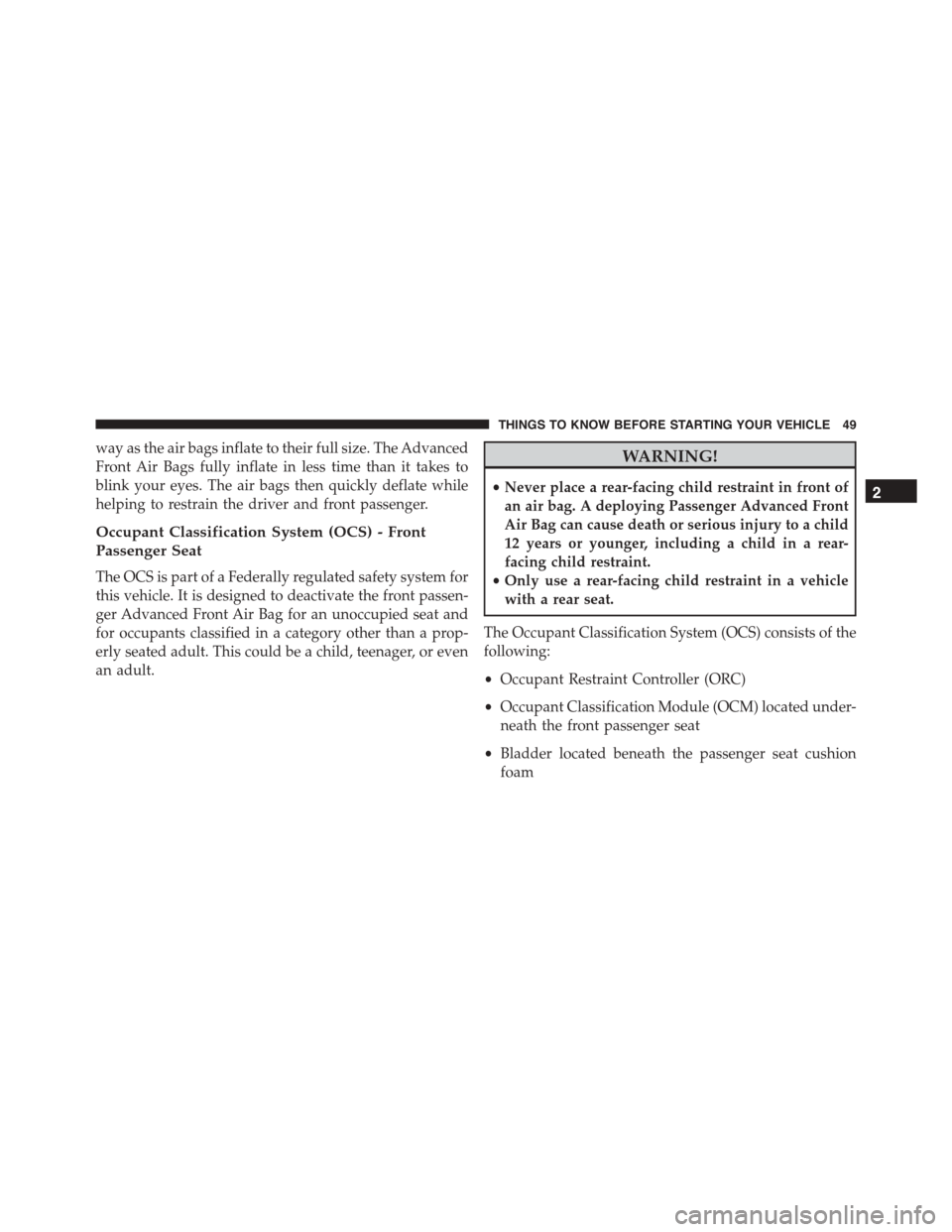
way as the air bags inflate to their full size. The Advanced
Front Air Bags fully inflate in less time than it takes to
blink your eyes. The air bags then quickly deflate while
helping to restrain the driver and front passenger.
Occupant Classification System (OCS) - Front
Passenger Seat
The OCS is part of a Federally regulated safety system for
this vehicle. It is designed to deactivate the front passen-
ger Advanced Front Air Bag for an unoccupied seat and
for occupants classified in a category other than a prop-
erly seated adult. This could be a child, teenager, or even
an adult.
WARNING!
•Never place a rear-facing child restraint in front of
an air bag. A deploying Passenger Advanced Front
Air Bag can cause death or serious injury to a child
12 years or younger, including a child in a rear-
facing child restraint.
•Only use a rear-facing child restraint in a vehicle
with a rear seat.
The Occupant Classification System (OCS) consists of the
following:
•Occupant Restraint Controller (ORC)
•Occupant Classification Module (OCM) located under-
neath the front passenger seat
•Bladder located beneath the passenger seat cushion
foam
2
THINGS TO KNOW BEFORE STARTING YOUR VEHICLE 49
Page 52 of 400
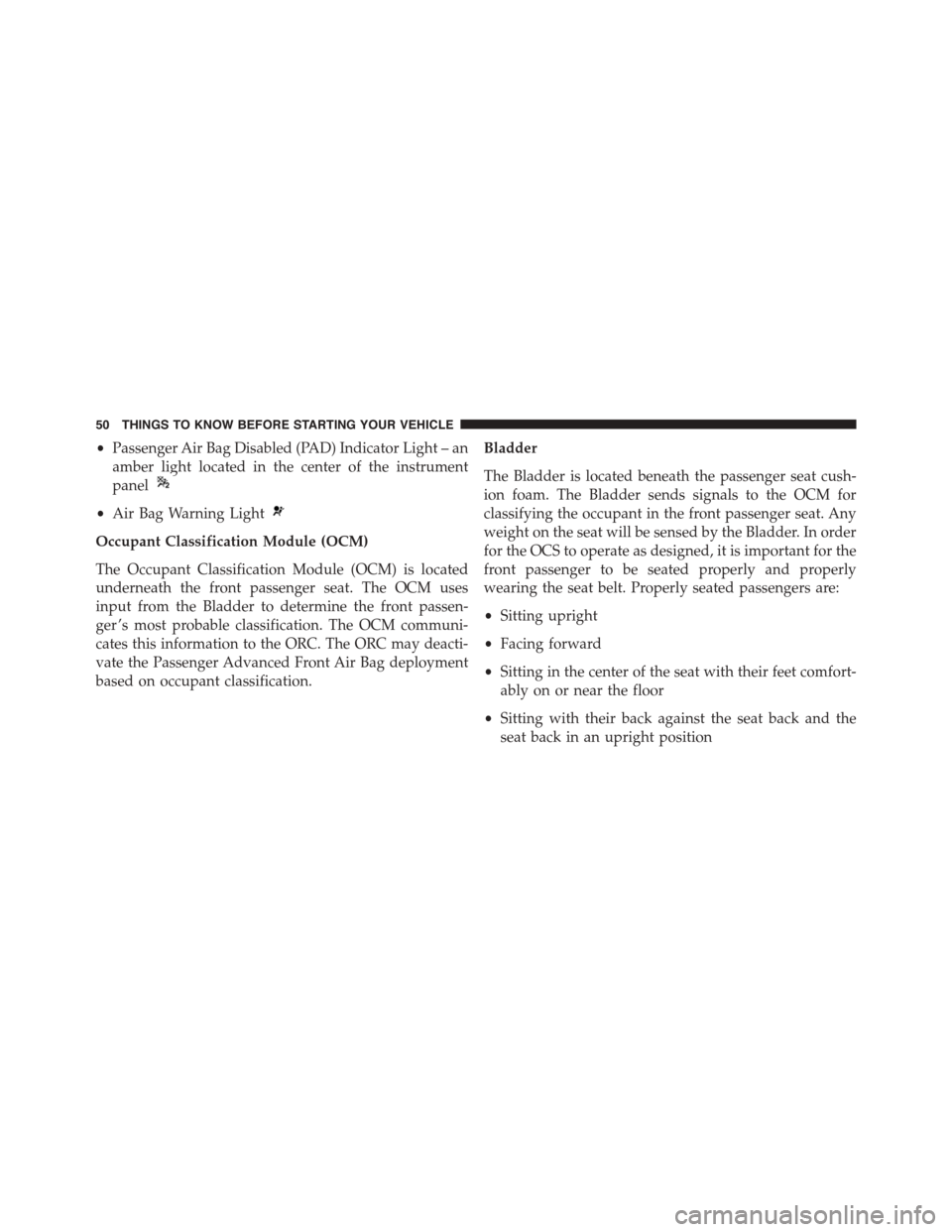
•Passenger Air Bag Disabled (PAD) Indicator Light – an
amber light located in the center of the instrument
panel
•Air Bag Warning Light
Occupant Classification Module (OCM)
The Occupant Classification Module (OCM) is located
underneath the front passenger seat. The OCM uses
input from the Bladder to determine the front passen-
ger ’s most probable classification. The OCM communi-
cates this information to the ORC. The ORC may deacti-
vate the Passenger Advanced Front Air Bag deployment
based on occupant classification.
Bladder
The Bladder is located beneath the passenger seat cush-
ion foam. The Bladder sends signals to the OCM for
classifying the occupant in the front passenger seat. Any
weight on the seat will be sensed by the Bladder. In order
for the OCS to operate as designed, it is important for the
front passenger to be seated properly and properly
wearing the seat belt. Properly seated passengers are:
•Sitting upright
•Facing forward
•Sitting in the center of the seat with their feet comfort-
ably on or near the floor
•Sitting with their back against the seat back and the
seat back in an upright position
50 THINGS TO KNOW BEFORE STARTING YOUR VEHICLE
Page 53 of 400
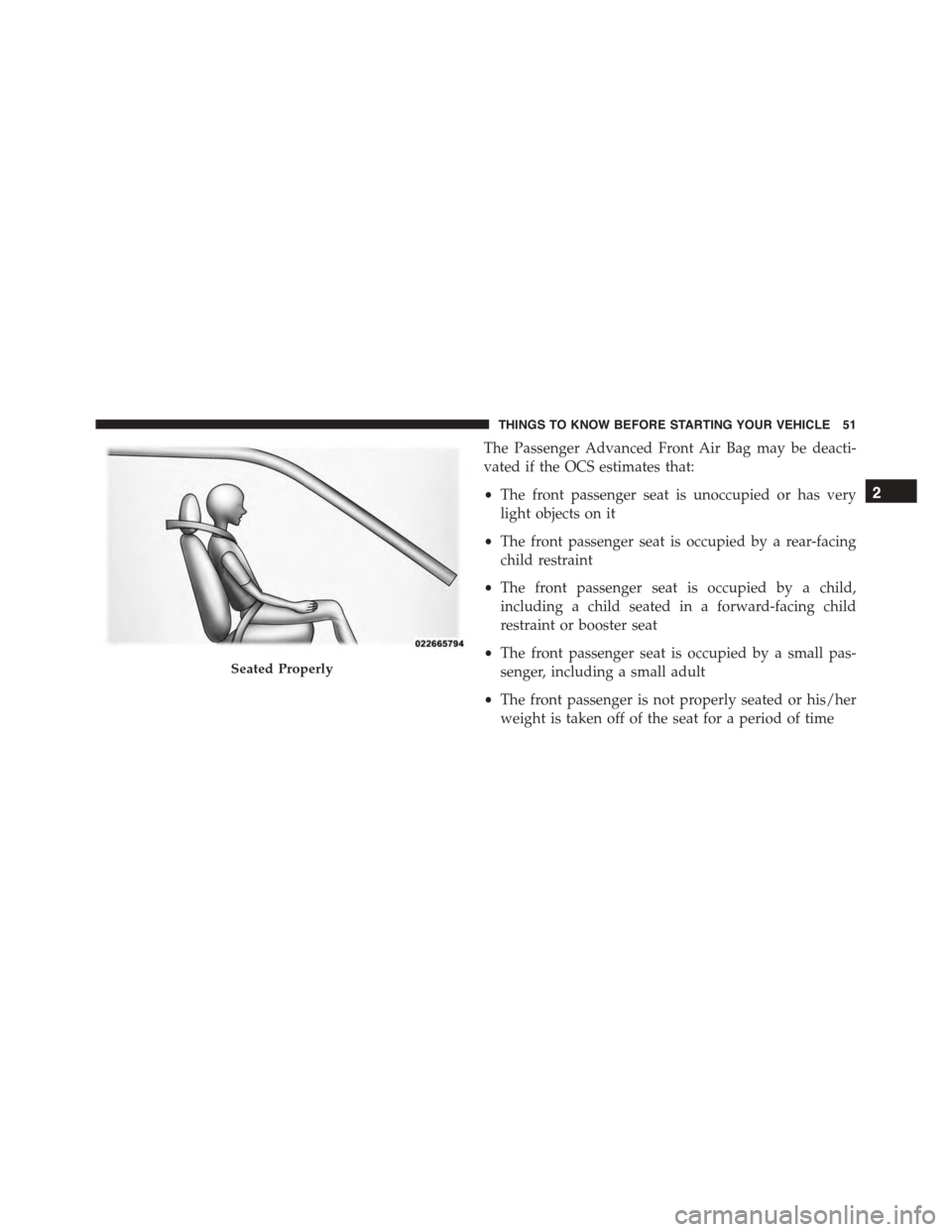
The Passenger Advanced Front Air Bag may be deacti-
vated if the OCS estimates that:
•The front passenger seat is unoccupied or has very
light objects on it
•The front passenger seat is occupied by a rear-facing
child restraint
•The front passenger seat is occupied by a child,
including a child seated in a forward-facing child
restraint or booster seat
•The front passenger seat is occupied by a small pas-
senger, including a small adult
•The front passenger is not properly seated or his/her
weight is taken off of the seat for a period of time
Seated Properly
2
THINGS TO KNOW BEFORE STARTING YOUR VEHICLE 51
Page 54 of 400
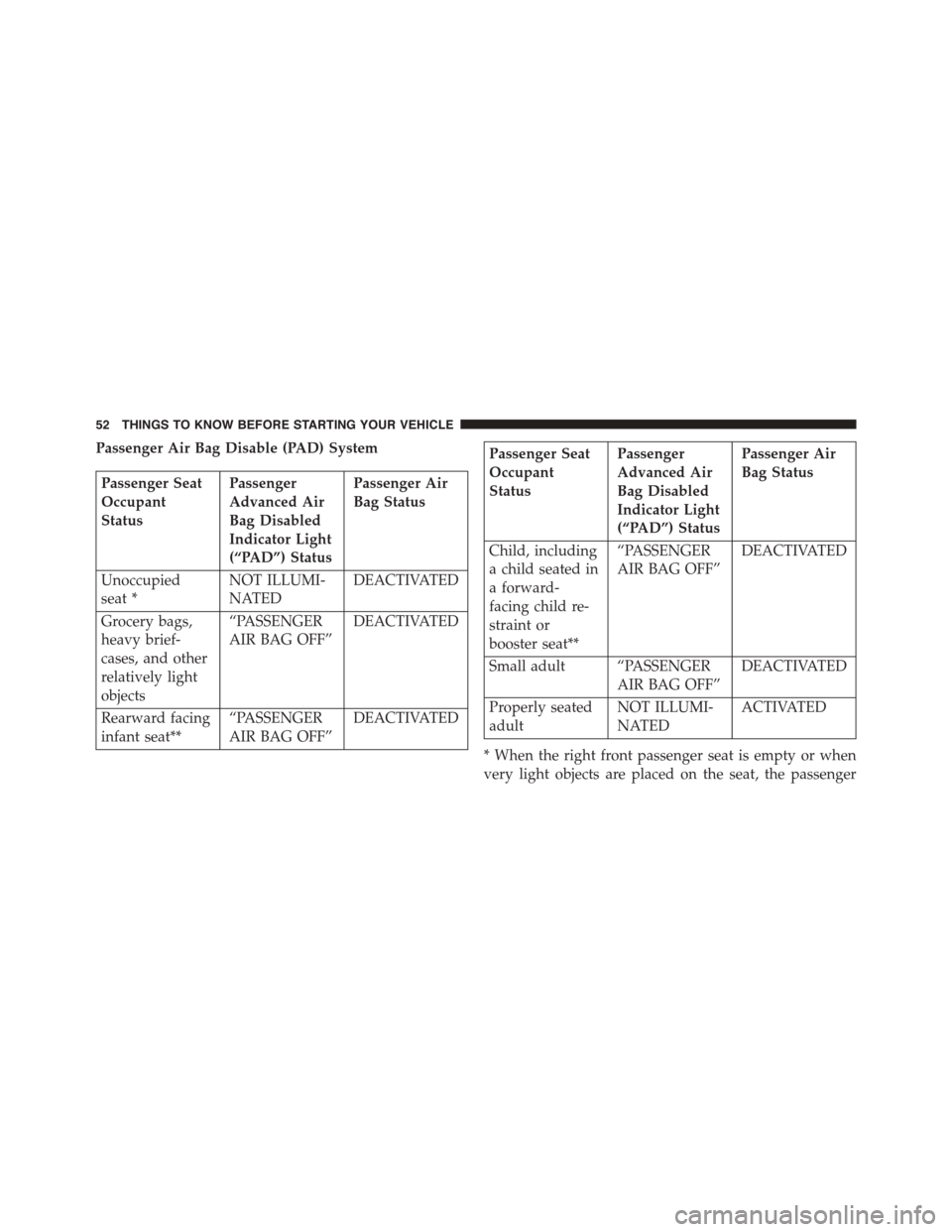
Passenger Air Bag Disable (PAD) System
Passenger Seat
Occupant
Status
Passenger
Advanced Air
Bag Disabled
Indicator Light
(“PAD”) Status
Passenger Air
Bag Status
Unoccupied
seat *
NOT ILLUMI-
NATED
DEACTIVATED
Grocery bags,
heavy brief-
cases, and other
relatively light
objects
“PASSENGER
AIR BAG OFF”
DEACTIVATED
Rearward facing
infant seat**
“PASSENGER
AIR BAG OFF”
DEACTIVATED
Passenger Seat
Occupant
Status
Passenger
Advanced Air
Bag Disabled
Indicator Light
(“PAD”) Status
Passenger Air
Bag Status
Child, including
a child seated in
a forward-
facing child re-
straint or
booster seat**
“PASSENGER
AIR BAG OFF”
DEACTIVATED
Small adult “PASSENGER
AIR BAG OFF”
DEACTIVATED
Properly seated
adult
NOT ILLUMI-
NATED
ACTIVATED
* When the right front passenger seat is empty or when
very light objects are placed on the seat, the passenger
52 THINGS TO KNOW BEFORE STARTING YOUR VEHICLE
Page 55 of 400
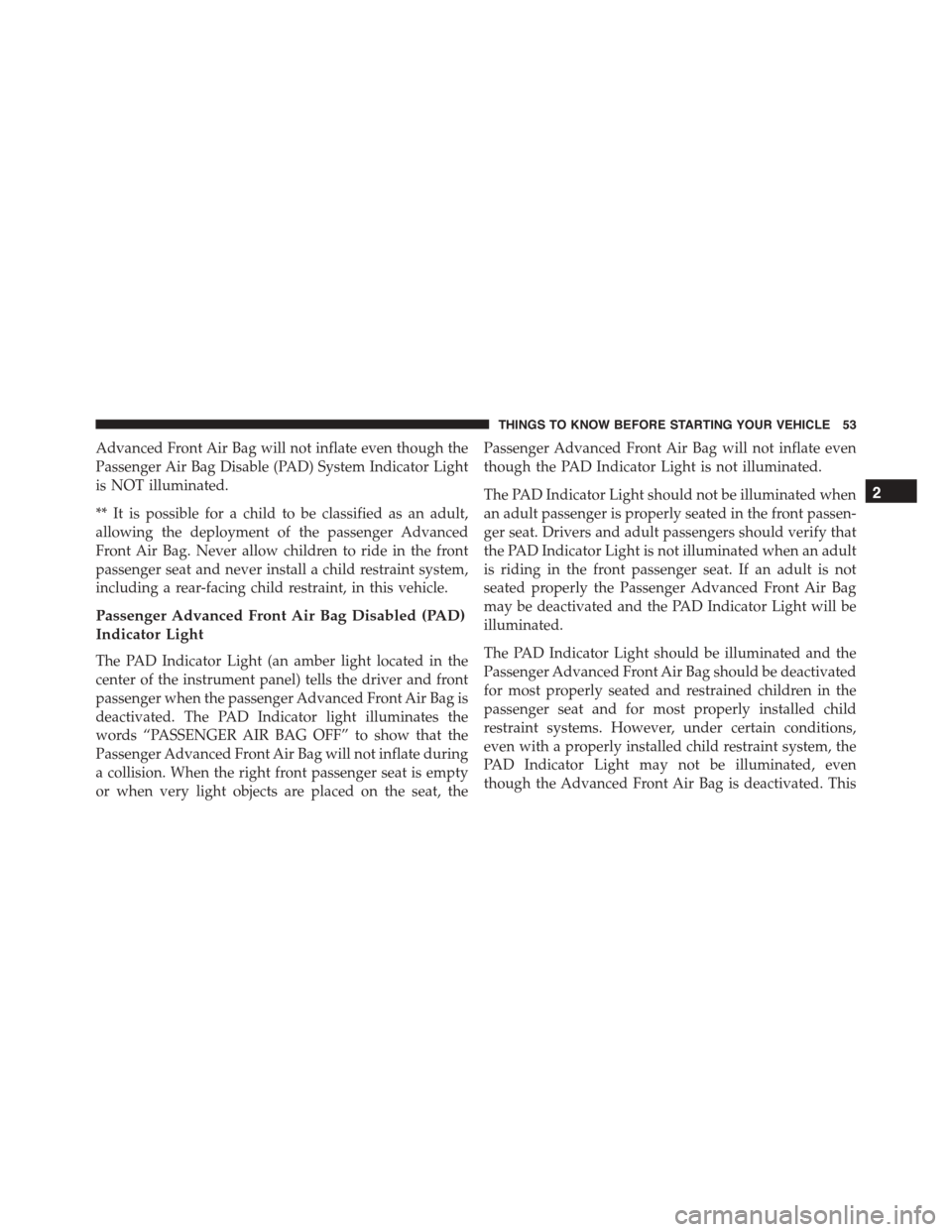
Advanced Front Air Bag will not inflate even though the
Passenger Air Bag Disable (PAD) System Indicator Light
is NOT illuminated.
** It is possible for a child to be classified as an adult,
allowing the deployment of the passenger Advanced
Front Air Bag. Never allow children to ride in the front
passenger seat and never install a child restraint system,
including a rear-facing child restraint, in this vehicle.
Passenger Advanced Front Air Bag Disabled (PAD)
Indicator Light
The PAD Indicator Light (an amber light located in the
center of the instrument panel) tells the driver and front
passenger when the passenger Advanced Front Air Bag is
deactivated. The PAD Indicator light illuminates the
words “PASSENGER AIR BAG OFF” to show that the
Passenger Advanced Front Air Bag will not inflate during
a collision. When the right front passenger seat is empty
or when very light objects are placed on the seat, the
Passenger Advanced Front Air Bag will not inflate even
though the PAD Indicator Light is not illuminated.
The PAD Indicator Light should not be illuminated when
an adult passenger is properly seated in the front passen-
ger seat. Drivers and adult passengers should verify that
the PAD Indicator Light is not illuminated when an adult
is riding in the front passenger seat. If an adult is not
seated properly the Passenger Advanced Front Air Bag
may be deactivated and the PAD Indicator Light will be
illuminated.
The PAD Indicator Light should be illuminated and the
Passenger Advanced Front Air Bag should be deactivated
for most properly seated and restrained children in the
passenger seat and for most properly installed child
restraint systems. However, under certain conditions,
even with a properly installed child restraint system, the
PAD Indicator Light may not be illuminated, even
though the Advanced Front Air Bag is deactivated. This
2
THINGS TO KNOW BEFORE STARTING YOUR VEHICLE 53
Page 56 of 400
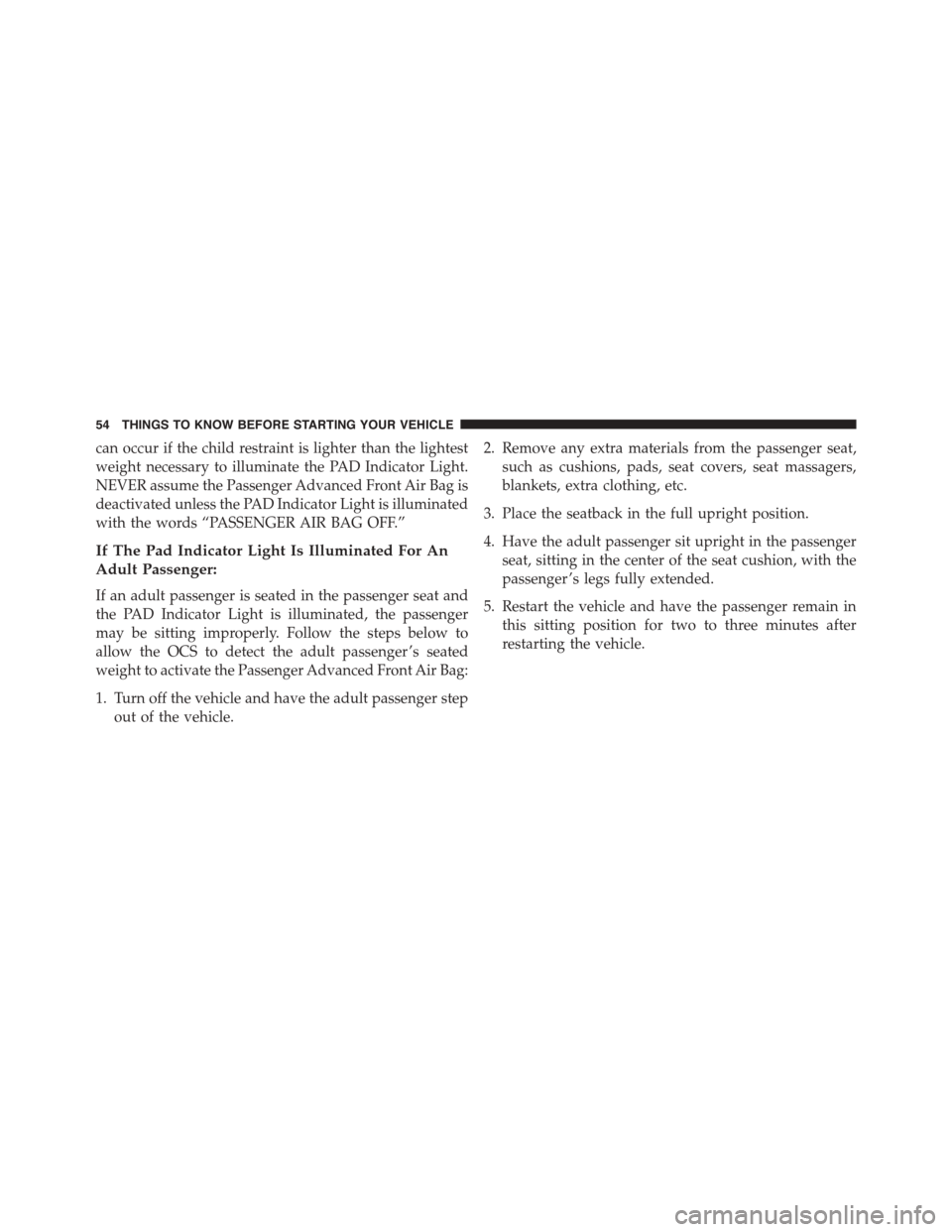
can occur if the child restraint is lighter than the lightest
weight necessary to illuminate the PAD Indicator Light.
NEVER assume the Passenger Advanced Front Air Bag is
deactivated unless the PAD Indicator Light is illuminated
with the words “PASSENGER AIR BAG OFF.”
If The Pad Indicator Light Is Illuminated For An
Adult Passenger:
If an adult passenger is seated in the passenger seat and
the PAD Indicator Light is illuminated, the passenger
may be sitting improperly. Follow the steps below to
allow the OCS to detect the adult passenger ’s seated
weight to activate the Passenger Advanced Front Air Bag:
1. Turn off the vehicle and have the adult passenger step
out of the vehicle.
2. Remove any extra materials from the passenger seat,
such as cushions, pads, seat covers, seat massagers,
blankets, extra clothing, etc.
3. Place the seatback in the full upright position.
4. Have the adult passenger sit upright in the passenger
seat, sitting in the center of the seat cushion, with the
passenger ’s legs fully extended.
5. Restart the vehicle and have the passenger remain in
this sitting position for two to three minutes after
restarting the vehicle.
54 THINGS TO KNOW BEFORE STARTING YOUR VEHICLE
Page 57 of 400
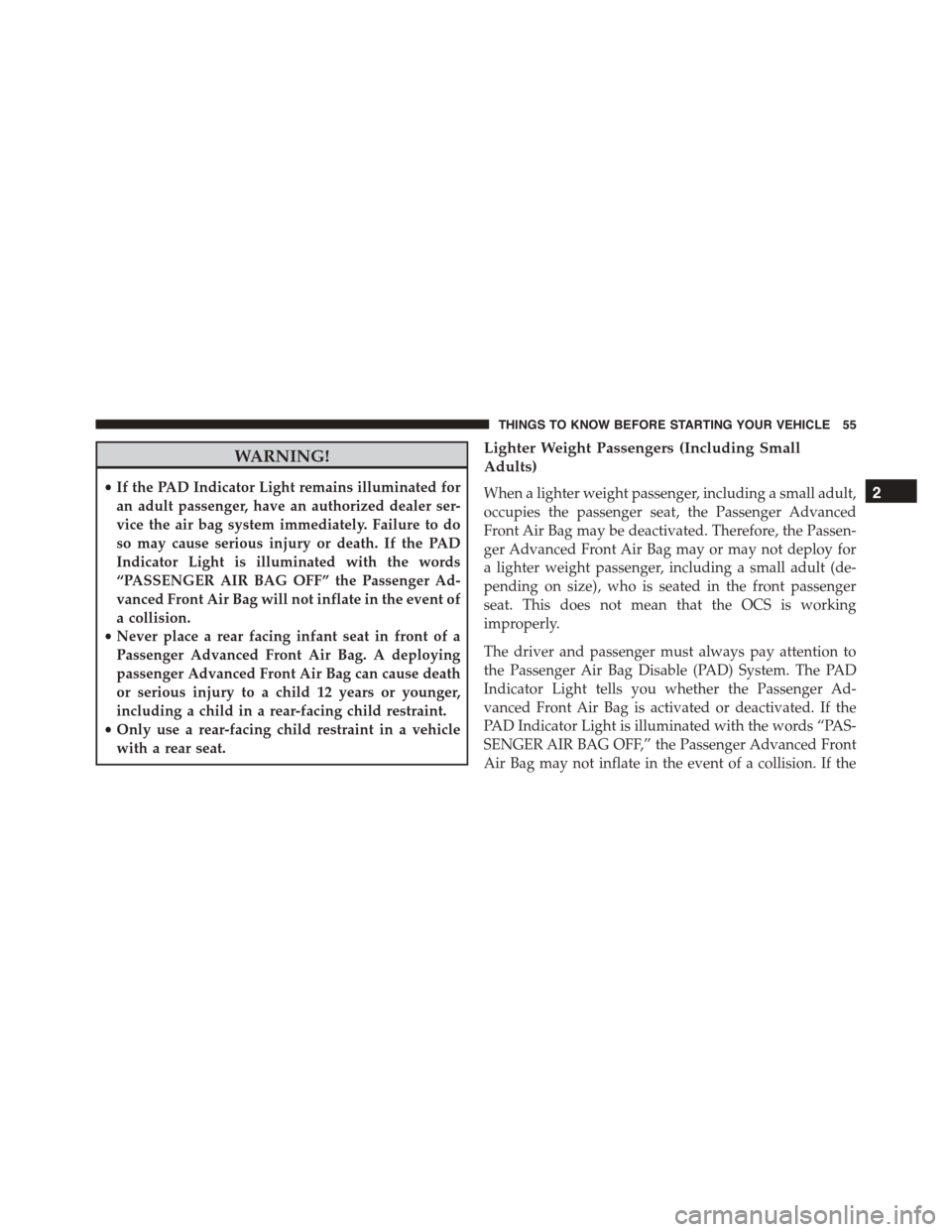
WARNING!
•If the PAD Indicator Light remains illuminated for
an adult passenger, have an authorized dealer ser-
vice the air bag system immediately. Failure to do
so may cause serious injury or death. If the PAD
Indicator Light is illuminated with the words
“PASSENGER AIR BAG OFF” the Passenger Ad-
vanced Front Air Bag will not inflate in the event of
a collision.
•Never place a rear facing infant seat in front of a
Passenger Advanced Front Air Bag. A deploying
passenger Advanced Front Air Bag can cause death
or serious injury to a child 12 years or younger,
including a child in a rear-facing child restraint.
•Only use a rear-facing child restraint in a vehicle
with a rear seat.
Lighter Weight Passengers (Including Small
Adults)
When a lighter weight passenger, including a small adult,
occupies the passenger seat, the Passenger Advanced
Front Air Bag may be deactivated. Therefore, the Passen-
ger Advanced Front Air Bag may or may not deploy for
a lighter weight passenger, including a small adult (de-
pending on size), who is seated in the front passenger
seat. This does not mean that the OCS is working
improperly.
The driver and passenger must always pay attention to
the Passenger Air Bag Disable (PAD) System. The PAD
Indicator Light tells you whether the Passenger Ad-
vanced Front Air Bag is activated or deactivated. If the
PAD Indicator Light is illuminated with the words “PAS-
SENGER AIR BAG OFF,” the Passenger Advanced Front
Air Bag may not inflate in the event of a collision. If the
2
THINGS TO KNOW BEFORE STARTING YOUR VEHICLE 55
Page 58 of 400
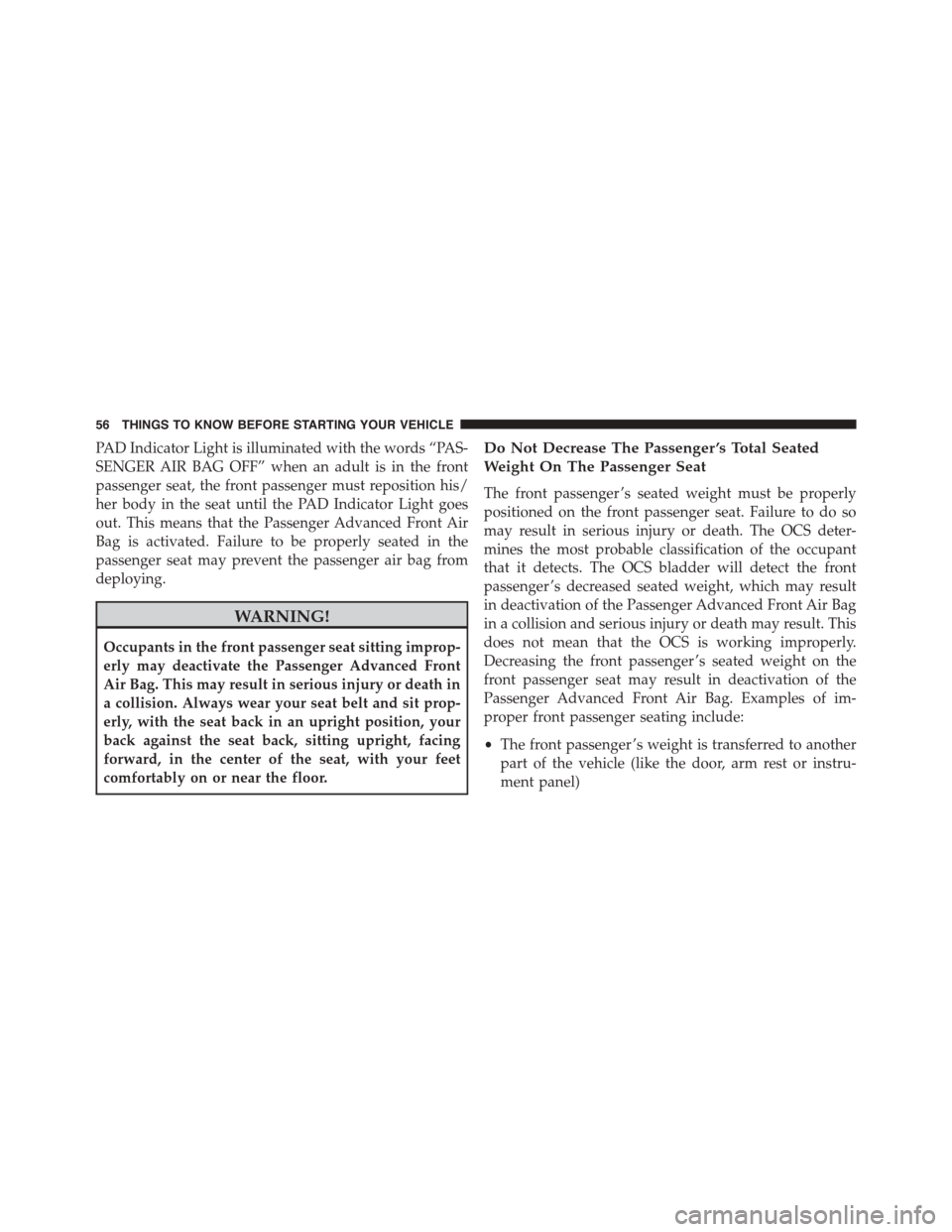
PAD Indicator Light is illuminated with the words “PAS-
SENGER AIR BAG OFF” when an adult is in the front
passenger seat, the front passenger must reposition his/
her body in the seat until the PAD Indicator Light goes
out. This means that the Passenger Advanced Front Air
Bag is activated. Failure to be properly seated in the
passenger seat may prevent the passenger air bag from
deploying.
WARNING!
Occupants in the front passenger seat sitting improp-
erly may deactivate the Passenger Advanced Front
Air Bag. This may result in serious injury or death in
a collision. Always wear your seat belt and sit prop-
erly, with the seat back in an upright position, your
back against the seat back, sitting upright, facing
forward, in the center of the seat, with your feet
comfortably on or near the floor.
Do Not Decrease The Passenger ’s Total Seated
Weight On The Passenger Seat
The front passenger ’s seated weight must be properly
positioned on the front passenger seat. Failure to do so
may result in serious injury or death. The OCS deter-
mines the most probable classification of the occupant
that it detects. The OCS bladder will detect the front
passenger ’s decreased seated weight, which may result
in deactivation of the Passenger Advanced Front Air Bag
in a collision and serious injury or death may result. This
does not mean that the OCS is working improperly.
Decreasing the front passenger ’s seated weight on the
front passenger seat may result in deactivation of the
Passenger Advanced Front Air Bag. Examples of im-
proper front passenger seating include:
•The front passenger ’s weight is transferred to another
part of the vehicle (like the door, arm rest or instru-
ment panel)
56 THINGS TO KNOW BEFORE STARTING YOUR VEHICLE
Page 59 of 400
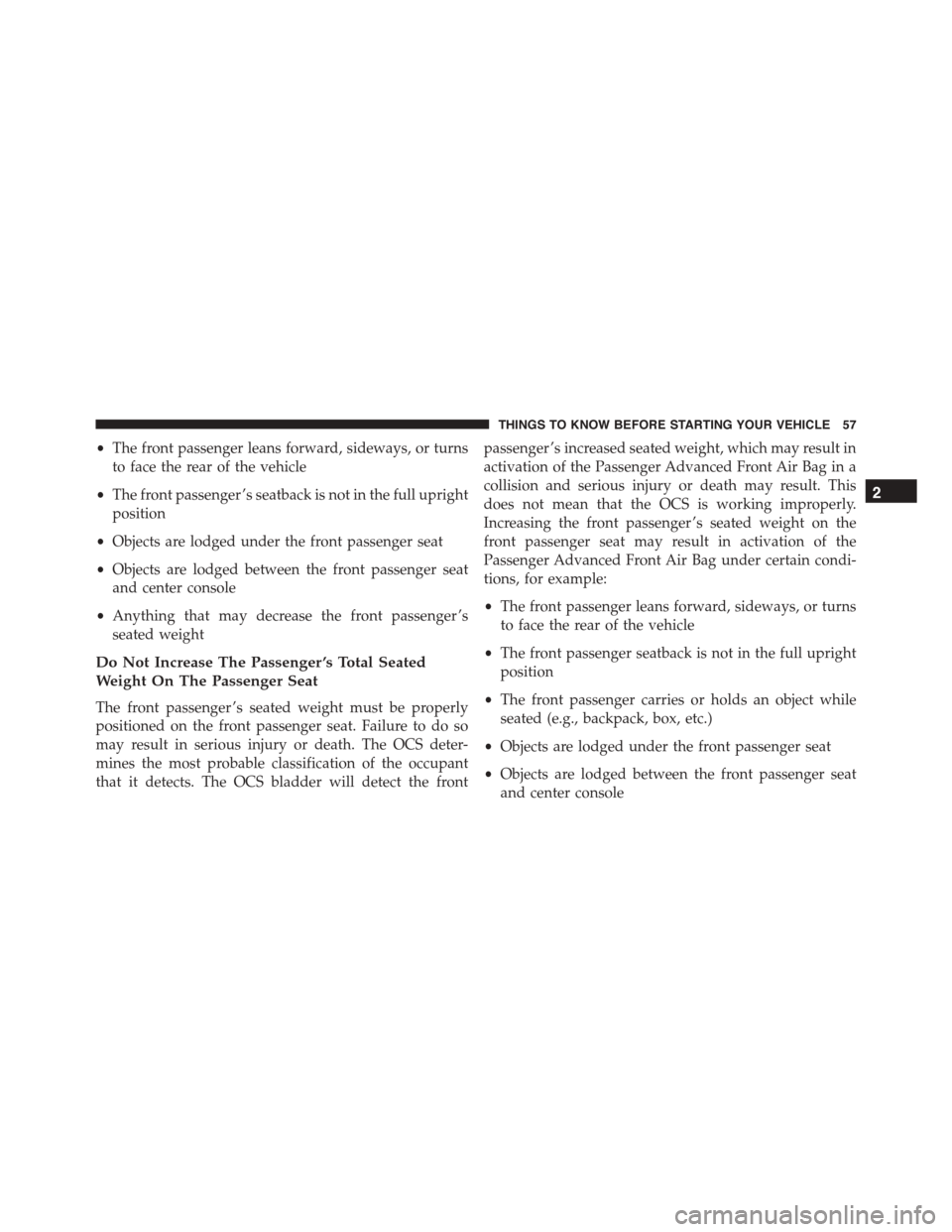
•The front passenger leans forward, sideways, or turns
to face the rear of the vehicle
•The front passenger ’s seatback is not in the full upright
position
•Objects are lodged under the front passenger seat
•Objects are lodged between the front passenger seat
and center console
•Anything that may decrease the front passenger ’s
seated weight
Do Not Increase The Passenger ’s Total Seated
Weight On The Passenger Seat
The front passenger ’s seated weight must be properly
positioned on the front passenger seat. Failure to do so
may result in serious injury or death. The OCS deter-
mines the most probable classification of the occupant
that it detects. The OCS bladder will detect the front
passenger ’s increased seated weight, which may result in
activation of the Passenger Advanced Front Air Bag in a
collision and serious injury or death may result. This
does not mean that the OCS is working improperly.
Increasing the front passenger ’s seated weight on the
front passenger seat may result in activation of the
Passenger Advanced Front Air Bag under certain condi-
tions, for example:
•The front passenger leans forward, sideways, or turns
to face the rear of the vehicle
•The front passenger seatback is not in the full upright
position
•The front passenger carries or holds an object while
seated (e.g., backpack, box, etc.)
•Objects are lodged under the front passenger seat
•Objects are lodged between the front passenger seat
and center console
2
THINGS TO KNOW BEFORE STARTING YOUR VEHICLE 57
Page 60 of 400
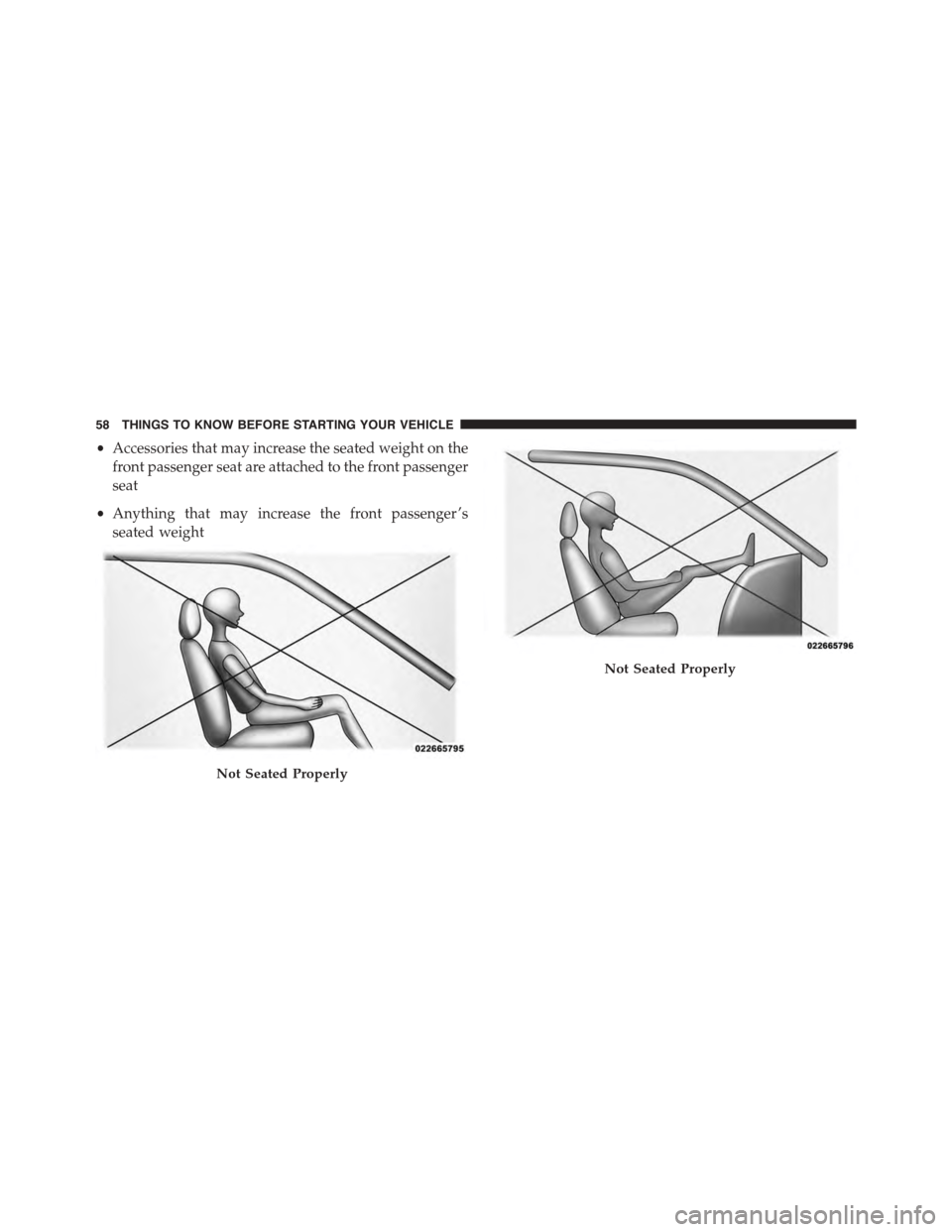
•Accessories that may increase the seated weight on the
front passenger seat are attached to the front passenger
seat
•Anything that may increase the front passenger ’s
seated weight
Not Seated Properly
Not Seated Properly
58 THINGS TO KNOW BEFORE STARTING YOUR VEHICLE